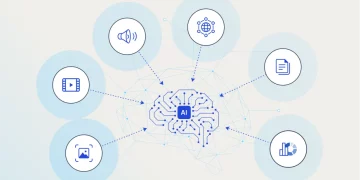Introduction
The financial industry has always been data-driven, with an emphasis on making informed decisions to mitigate risk, optimize operations, and maximize profits. As technology continues to evolve, Artificial Intelligence (AI) is emerging as a game-changer in financial services. AI’s ability to process vast amounts of data, learn from patterns, and predict future trends has the potential to transform both risk management and customer experience in banking.
From fraud detection to personalized financial advice, AI is not only improving internal operations but also offering enhanced services to customers. In this article, we will explore some of the innovative applications of AI in the financial sector and examine how they help banks manage risk more effectively while providing a superior customer experience.
1. AI in Risk Management: Predicting and Mitigating Financial Risks
1.1 AI for Fraud Detection and Prevention
Financial institutions are prime targets for fraudulent activities due to the volume and value of transactions they handle. AI is playing a crucial role in helping banks detect and prevent fraud, using sophisticated algorithms to monitor and analyze transactions in real-time.
Case Study: JPMorgan Chase and AI-Driven Fraud Detection
- Challenge: Fraudulent activities like identity theft, account takeover, and credit card fraud result in billions of dollars in losses annually. Traditional methods of fraud detection often rely on rule-based systems that can be bypassed by sophisticated fraudsters.
- AI Solution: JPMorgan Chase employs machine learning models to analyze vast amounts of transaction data and detect unusual patterns that might indicate fraudulent activity. The system learns from historical data, continuously adapting to new fraud tactics and flagging suspicious transactions in real-time.
- Outcome: The AI system has significantly reduced the false-positive rate, enabling the bank to identify genuine fraud cases faster while minimizing disruption to legitimate customers. JPMorgan Chase has reported a 30% improvement in fraud detection accuracy.
Other Notable Fraud Detection Systems:
- Mastercard: Mastercard’s AI-powered Decision Intelligence platform helps detect and prevent fraud by analyzing over 500 million transactions per day, learning from each new case to improve accuracy.
- HSBC: The bank uses AI algorithms to identify fraudulent credit card transactions in real-time, providing customers with immediate alerts and blocking transactions if necessary.
1.2 AI in Credit Risk Assessment and Loan Approval
Credit risk management is another area where AI is making a profound impact. Traditional methods of credit scoring often rely on limited data, which can lead to inaccurate assessments, especially for individuals with limited credit histories. AI can analyze alternative data such as social media activity, transaction history, and even mobile phone usage to assess creditworthiness more accurately.
Case Study: Zest AI and AI-Driven Credit Scoring
- Challenge: Traditional credit scoring methods often fail to assess the risk of individuals who do not have extensive credit histories, such as young borrowers or those in underserved populations.
- AI Solution: Zest AI uses machine learning algorithms to assess creditworthiness by analyzing alternative data sources. The system creates a more comprehensive credit profile by examining factors such as income, spending habits, and even mobile phone payment behavior.
- Outcome: Zest AI’s credit scoring model has been shown to provide more accurate assessments of credit risk, leading to higher approval rates for individuals who may have been overlooked by traditional systems. The company claims its AI model has helped increase loan approval rates by 20% while reducing defaults.
1.3 AI for Portfolio Management and Investment Risk Analysis
AI is not just revolutionizing the way banks manage individual loans and transactions; it’s also helping financial institutions with complex tasks such as portfolio management and investment risk analysis. AI-driven tools allow financial managers to optimize portfolios by predicting market trends and identifying potential risks based on vast amounts of data.
Case Study: BlackRock’s Aladdin Platform
- Challenge: Investment managers often struggle with evaluating risks and making data-driven decisions due to the sheer volume of financial data available.
- AI Solution: BlackRock’s Aladdin platform uses AI and machine learning to provide investment professionals with real-time data and risk analytics. The system helps manage portfolios by predicting market trends, assessing financial risks, and optimizing asset allocation based on the latest data.
- Outcome: Aladdin has become a crucial tool for over 200 institutional clients, helping them make better investment decisions and mitigate risk. According to BlackRock, Aladdin has helped manage assets worth over $21 trillion and improve overall portfolio performance by reducing risk exposure.
2. AI in Customer Experience: Enhancing Engagement and Personalization
2.1 AI-Powered Chatbots and Virtual Assistants
In the financial industry, providing instant, reliable, and personalized customer support is key to retaining customers. AI-powered chatbots and virtual assistants are now being used by many banks to interact with customers in real-time, answer queries, and resolve issues.
Case Study: Bank of America’s Erica
- Challenge: Banks are dealing with an ever-increasing volume of customer inquiries, making it challenging to provide timely and efficient service.
- AI Solution: Bank of America’s Erica is an AI-powered virtual assistant designed to help customers with their financial needs. Erica uses natural language processing (NLP) to understand customer queries and provide personalized responses, from checking account balances to recommending budgeting tips.
- Outcome: Since its launch, Erica has assisted millions of customers, handling over 50 million customer requests. The bank reports that Erica has improved customer satisfaction by offering a convenient, 24/7 self-service option, reducing wait times and helping customers get the information they need quickly.
Other AI Chatbots in Banking:
- NatWest’s Cora: Cora is an AI chatbot used by NatWest to handle customer service inquiries and transactions, reducing response time and enhancing customer engagement.
- Royal Bank of Scotland’s Luvo: Luvo provides customers with immediate access to a wide range of services, from account management to financial advice.
2.2 Personalized Financial Services and Wealth Management
AI is also playing a pivotal role in delivering personalized financial services. By analyzing transaction data and user preferences, banks can offer highly targeted financial products, investment advice, and savings plans, helping customers make better financial decisions.
Case Study: DBS Bank’s NAV Planner
- Challenge: Customers often struggle with understanding their financial goals and the steps needed to achieve them.
- AI Solution: DBS Bank in Singapore has introduced the NAV Planner, an AI-powered financial planning tool that offers personalized wealth management advice. The system analyzes customers’ financial data and recommends a tailored savings and investment plan to help them meet their goals.
- Outcome: Since the launch of NAV Planner, DBS Bank has seen increased engagement with its wealth management services, with users benefiting from personalized, data-driven financial planning and achieving better long-term financial outcomes.

2.3 AI in Fraud Detection for Customer Transactions
Fraud detection is critical to customer trust, and AI can offer real-time insights into potentially fraudulent transactions, alerting customers and banks to suspicious activities.
Case Study: PayPal’s AI-Driven Fraud Prevention
- Challenge: With millions of online transactions happening every day, PayPal faces significant challenges in preventing fraudulent transactions.
- AI Solution: PayPal uses AI to detect fraudulent activities by analyzing user transaction behavior. The AI system learns from historical data and continuously improves its fraud detection models to identify suspicious patterns, even before a transaction is flagged by human analysts.
- Outcome: PayPal’s AI-powered fraud detection system is able to prevent fraud with a high degree of accuracy, reducing both financial losses and customer dissatisfaction. In fact, the company claims to have saved millions of dollars by using AI to predict and prevent fraud in real-time.
3. Challenges and the Future of AI in Finance
Despite the many successes of AI in the financial industry, challenges remain:
- Data Privacy and Security: The use of AI in analyzing sensitive financial data raises concerns about data breaches and privacy violations. Financial institutions must ensure robust cybersecurity measures are in place.
- Regulatory Compliance: As AI technologies evolve, financial institutions must navigate the complex and ever-changing regulatory landscape to ensure they comply with local and international laws.
- Bias and Fairness: AI models must be carefully designed to avoid biases that could lead to discriminatory practices in credit scoring or lending.
However, as these challenges are addressed, the potential for AI in banking will continue to grow. We can expect further advancements in AI-driven automation, blockchain integration, and predictive analytics, all of which will create a more efficient, secure, and customer-centric financial landscape.
Conclusion
AI is undoubtedly transforming the financial sector, offering new tools and technologies that improve both risk management and customer experience. From fraud detection and credit scoring to personalized banking services and wealth management, AI is enabling banks to operate more efficiently, deliver better services, and stay ahead of emerging risks.
As AI technology continues to mature, its role in finance will only increase, creating opportunities for both institutions and customers alike. Banks that embrace AI’s potential will be better equipped to navigate the evolving financial landscape, ensuring better outcomes for themselves and their customers.











































